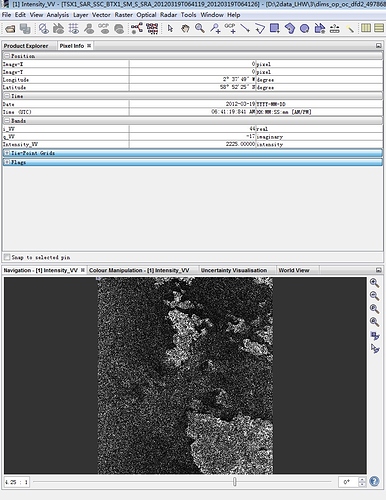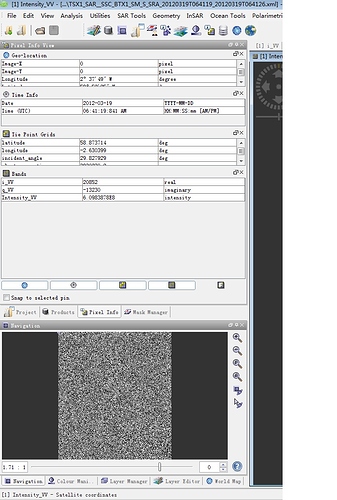After reading the same TerraSAR-X SLC complex data with SNAP and NEST, respectively, I check the real part , imaginary part and intensity, and find that the results of SNAP and NEST are different. For example, in the same point of the same data, the real part, imaginary part and intensity of NEST is 20852, -13230 and 6.09839E8, respectively. But the real part, imaginary part and intensity of SNAP is 44, -17 and 2225, respectively.
Why does the difference appear?
Why is there difference between the real part of complex data read by NEST and SNAP.
What is NEXT? Or do you mean NEST?
I guess so. NEST was found in the windows start menu under Next ESA SAR Toolbox 

Yes, it’s NEST.
I guess that SNAP does some calibrations, but the calibrations is different from the content on page 252 of “TerraSAR-X Ground Segment level-1b-product-format-specification_1.3”, in which there is only the calibration method of intensity.
I don’t understand your point.
Can you please post screenshots that illustrate the problem?
root(i²+q²) = DN
Beta0 = k*|DN|²
where k is the calibration constant from the metadata.
https://spacedata.copernicus.eu/documents/12833/14537/TerraSAR-X_RadiometricCalculations
Thank you very much for you reply!
The intensity figure read by SNAP is:
But the intensity figure read by NEST is:
Obviously, this two result is different.
Then I check the real part, imaginary part, and intensity of same location point (the coordinates are X=0, Y=0 ):
The result read by SNAP is:
And the result read by NEST is:
And I programmed with FORTRAN to read this data, get the result same as NEST. I guess that the result read by NEST should be the digital numbers (integer pixel values) of TerraSAR-X SLC complex data. And I try to calibrated it with the following methold, which come from page 252 of the specification called “TerraSAR-X_level-1b-product-format-specification_1.3”.
But the calibrated result is similar to the result read by NEST, and different from the result read by SNAP.
Is the real part and imaginary part calibrated when SNAP reads the data? If yes, what is the calibration method?
Sorry, because newcomers can only send two pictures, I reply to you three times.
I would say the Intensity band created by NEST is not correct.
real and imaginary parts are correct in both cases. What is your overall aim?
My ultimate aim is extract the argument of complex data, then obtain the ocean surface current.
When verify the process of angle extraction is right or not, I check the data read by my program, NEST, and SNAP, respectively, and find the problem as described above.
Does the correction of real and imaginary parts affect the argument of complex data?
And where can I study the correction methold of real and imaginary parts of comlex SLC data?
that exceeds my knowledge on complex data, sorry.
Thank you very much for discussing this with me!
Yes, my mean is NEST.
Think you very much for your reply!
And another question: How are the real and imaginary parts of complex data calibrated when the TerraSAR-X SLC complex data is read by SNAP?
Thank you very much for discussing this with me!
Following up on this thread for anyone having the same problem:
This is likely due to COSAR v2 data (from TanDEM-X) being stored as half-precision floats rather than integers, which some programs are not aware of which leads to datatype issues such as what you are encountering. I encountered this problem which was determined and fixed in this GitHub issue.




